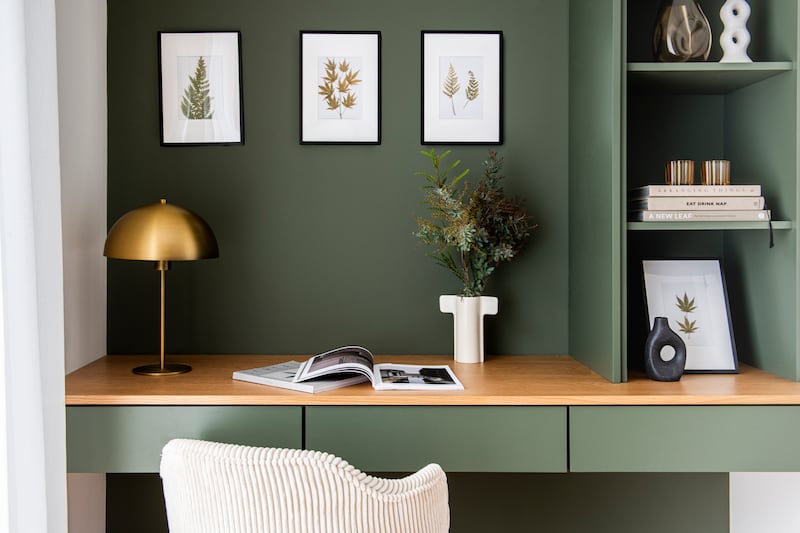When space is tight, it might be tempting to take a minimalist approach to decorating. But there’s an argument for challenging the status quo and embracing maximalism in a compact abode. Smaller spaces offer the perfect canvas for expressing personality. By strategically introducing the right textures, patterns, colours and furniture, even the tiniest spaces can feel sumptuous without appearing cramped.
Functionality first
When it comes to furniture, functionality is critical. Conceal-and-reveal-style storage or workstations, extendable tables and built-in beds offer clever solutions for maximising space without sacrificing style. Sofas featuring modular designs or removable cushions provide flexible seating and serve as extra beds when needed.
Go big
In a tight area, trying to maximise space by using only smaller furniture items is common. However, overfilling a small room with small furniture can make it feel cluttered.
Strategically incorporating oversized pieces in a small space can create a sense of comfort and elegance. The trick is experimenting with scale, balancing larger items with smaller ones. For instance, combine an oversized armchair with a slender, modern sofa. This juxtaposition of proportions can make the room feel more inviting while maintaining a sense of visual harmony.
Joanne McNally: ‘I was like, I’ll absolutely fly to Ireland and play golf with Bill Murray’
Ireland’s new fast casual food: 10 top dishes to grab and go
‘I’m single in my 40s, and I feel both pressure and disapproval from everyone’
Pancreatic cancer: ‘I’ve had this niggling pain in my left side,’ said Mum
When it comes to rugs, bigger is definitely better. A larger rug will help to expand a room visually. When deciding how big to go, the rule of thumb is to ensure that all the furniture sits comfortably on the rug, or at least the front legs of the sofa and chairs. Anything smaller will tend to feel awkward and make the space feel pokey.
[ It’s possible to design a home that boosts wellbeing and increases your focusOpens in new window ]
Play with pattern
Although traditional wisdom suggests avoiding bold patterns in small spaces, there’s no need to shy away from them. Patterns can breathe life into even the smallest of rooms when skilfully combined. The key is to carefully curate your choices by limiting your colour palette to a maximum of three shades and experimenting with scale and geometry.
Mix bold, graphic stripes with delicate floral patterns to achieve a harmonious blend, creating an unexpected yet complementary contrast. For instance, pair a striped rug with floral cushions or upholstery. Choose complementary colours to tie the look together.
Don’t be afraid to mix different textures alongside bold patterns. For example, pair a velvet sofa with a patterned rug and a textured throw. Mixing textures adds depth and visual interest to the space while maintaining cohesion.

Be brave
People often think that painting a small room in a light colour will make it feel bigger. This isn’t always true, and depending on the amount of natural light the room has, a pale colour might make it feel too cold. A north-facing room painted white, for example, will feel quite sterile.
In a small room, embrace its size and aim to make it feel cosy by painting it a darker shade. Doing this won’t make the room feel smaller but will create an intimate and relaxing space.
Create a dramatic statement by sticking to a single bold colour throughout the room. Whether emerald green, royal blue, or rich burgundy, using one dominant colour can make a small space feel cohesive and impactful. Experiment with different shades and textures within the same colour family to add depth.
[ ‘My husband’s attempts were a disaster’: The women DIYing it for themselvesOpens in new window ]
Layered lighting
Lighting plays a crucial role in enhancing the perception of space. Layered lighting, including overhead fixtures and lamps, adds warmth and ambience to small rooms without overwhelming them.
Decorative lighting, such as pendant lights, will add an attractive feature to your space. For example, table and floor lamps or concealed lighting in joinery units are ideal for creating ambience or mood lighting.
Consider replacing floor and table lamps with wall lights in tight spaces to optimise floor space. Wall lights serve a dual purpose as both a decorative element and a practical solution. If hard-wired fixtures don’t fit your budget, there’s an array of stylish plug-in wall lights available as alternatives.
Custom cabinetry
Bespoke joinery, designed to fit the exact dimensions of a room, offers a seamless and efficient way to maximise storage and minimise clutter. By investing in customised storage solutions, you can create a tailored fit that organises your belongings effortlessly and adds a visually appealing element to your space.
Custom cabinetry ensures that every inch of storage is optimised for functionality while maintaining a sleek and discreet appearance. This level of personalisation allows you to design a solution that perfectly meets your unique needs and enhances your room’s overall aesthetic.

Ceiling’s the limit
When designing a room, especially a small one, ceilings are frequently overlooked in the colour scheme planning process. However, ceilings present an additional canvas for creativity and experimentation. Don’t feel limited to white, even in compact spaces. Consider painting your ceiling to match the walls; a dark shade can create a cosy, cocoon-like atmosphere, while a lighter shade can evoke a calming ambience.
Alternatively, make a bold statement by selecting a colour that contrasts with your walls. This approach can add visual interest and character to your space, drawing the eye upward and making the room feel more expansive.
















